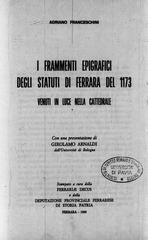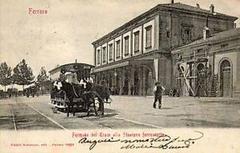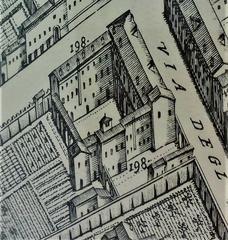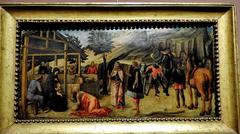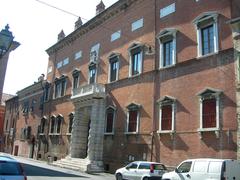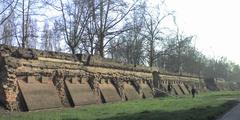Ex Monastero di San Paolo, Ferrara, Italy: Visiting Hours, Tickets, and Historical Sites Guide
Date: 14/06/2025
Introduction
The Ex Monastero di San Paolo in Ferrara is a remarkable testament to the city’s rich religious, artistic, and civic heritage. Established in the 10th century as a Benedictine monastery dedicated to Saint Paul, this historic complex has evolved through Romanesque, Renaissance, and Baroque phases—reflecting Ferrara’s significance as a religious, artistic, and political center in northern Italy. Today, following extensive restorations, it serves as both a vibrant cultural landmark and an active community hub, offering visitors an immersive journey through centuries of history, art, and tradition (FerraraToday, Ferrara Terra e Acqua, Biblioteca del Seminario di Ferrara).
Historical Overview
Origins and Medieval Foundation
The monastery’s foundation in the 10th century aligned with Ferrara’s emergence as a key ecclesiastical center in the Po Valley. Supported by local nobility and the Este family, the Benedictine community contributed to the city’s spiritual and intellectual life—serving as a center for manuscript production, agricultural development, and charity.
Architectural Evolution
The Ex Monastero di San Paolo’s architecture reflects Ferrara’s layered history. The original Romanesque structure featured austere stonework and semicircular arches. Renaissance enhancements under the Este family added harmonious proportions, classical columns, and elaborate frescoes. The 17th and 18th centuries introduced Baroque elements, including ornate stuccoes and richly decorated chapels, while the core medieval structure remains visible in certain sections (Biblioteca del Seminario di Ferrara).
Secularization and Modern Use
Napoleonic suppression in the late 18th century led to the monastery’s confiscation and repurposing for civic uses—ranging from a jail to municipal offices. Despite these changes, significant efforts in the late 19th and 20th centuries focused on preserving its most important historical and artistic elements.
Artistic and Cultural Significance
Artistic Masterpieces
The church is often regarded as a “museum within a church,” featuring works by Scarsellino (Il ratto di Elia), Bastianino, Girolamo da Carpi, and Domenico Mona. The chapels display a blend of late Mannerist and Baroque styles, with monochrome frescoes, gilded details, polychrome marble altars, and illusionistic painted elements that invite spiritual contemplation (Ferrara Terra e Acqua).
Civic and Religious Role
The Chiesa di San Paolo, adjacent to the monastery, is known as the “pantheon” of Ferrara, housing the tombs of notable figures such as Dosso Dossi and Bernardo Tasso (Informagiovani Italia). Its proximity to Ferrara’s cathedral and central commercial routes has made it integral to both religious and civic life.
Restoration Efforts
Recent Restorations (2012–2025)
Damaged by earthquakes in 1570 and 2012, the complex underwent an extensive restoration campaign from 2021–2025, funded by the Italian Ministry of Culture and the Emilia-Romagna Region (Finestre sull’Arte, Il Resto del Carlino). Key interventions included:
- Structural consolidation for seismic safety
- Conservation of major artworks (e.g., Scarsellino’s frescoes, wooden choir, Renaissance organ)
- Restoration of the Renaissance cloisters and medieval frescoes
The reopening in 2024–2025 reinvigorated the site’s religious, cultural, and community functions.
Contemporary Use and Community Engagement
Civic Integration
The Ex Monastero di San Paolo now houses municipal offices in its restored cloisters, facilitating daily interaction between administration and citizens (Cronaca Comune). The church itself remains an active place of worship, hosting regular services and Eucharistic Adoration.
Cultural and Educational Activities
The complex regularly hosts exhibitions, concerts, guided tours, and educational workshops, serving as a living classroom for art, architecture, and urban history. Community events—including those linked to the Palio di Ferrara—underscore its continued role in Ferrara’s civic life (Palio di Ferrara).
Visiting Information
Location
- Address: Corso Porta Reno 60 / Piazzetta Alberto Schiatti, Ferrara
- How to Get There: Centrally located, within walking distance from Ferrara’s main train station; accessible by bus; limited nearby parking
Visiting Hours
- Chiesa di San Paolo: Open Saturdays 16:00–18:00 and Sundays 10:00–12:00 (primarily for religious services; hours may vary; consult Inferrara Eventi for updates)
- Ex Monastero di San Paolo: Open for civic use and guided tours by appointment; check with municipal offices for public access times
Tickets
- Entrance Fee: Free for worship; donations appreciated; fees may apply for guided tours or special events
- Booking: Guided tours available by reservation through the Ferrara tourism portal
Accessibility
- Facilities: Partial accessibility (ramps and accessible restrooms in main areas)
- Limitations: Some historic sections may have limited access due to conservation
Visitor Tips
- Dress modestly; maintain silence during religious services
- Non-flash photography is allowed except during services or in restricted areas
- Use the MyFE Card for discounts on heritage sites and events (Inferrara Eventi)
- Plan visits around the Palio di Ferrara for a unique cultural experience (Ferrara Terra e Acqua)
Nearby Attractions
While at the Ex Monastero di San Paolo, visitors can also explore:
- Castello Estense
- Palazzo dei Diamanti
- Ferrara Cathedral
All are within walking distance, contributing to a rich, immersive experience of Ferrara’s UNESCO-listed heritage.
Visuals and Media
High-quality images and virtual tours are available on the official Ferrara tourism website. For enhanced engagement, use alt text such as “San Paolo Ferrara visiting hours” and “San Paolo Ferrara tickets” for images.
Frequently Asked Questions (FAQ)
Q: What are the current visiting hours?
A: Saturdays 16:00–18:00 and Sundays 10:00–12:00 for the church. Hours for the monastery’s civic spaces and tours may vary; check official sources.
Q: Is there an entrance fee?
A: No fee for worship; guided tours and events may require tickets.
Q: Are guided tours available?
A: Yes, book in advance through the Ferrara tourism portal.
Q: Is the site accessible for visitors with disabilities?
A: Main areas are accessible; contact ahead for specific needs.
Q: How can I reach the site?
A: Centrally located; easily reached by foot, public transport, or car (limited parking).
Q: Can I take photos inside?
A: Non-flash photography is usually allowed except during services or in restricted areas.
Conclusion and Call to Action
The Ex Monastero di San Paolo encapsulates over a millennium of Ferrara’s religious, artistic, and civic tradition. Its recent restoration and adaptive reuse have preserved invaluable heritage while revitalizing its role in community life. Visitors are encouraged to take advantage of guided tours, explore nearby historical sites, and engage with Ferrara’s vibrant cultural scene.
Plan your visit:
- Consult updated hours and ticket information on official platforms
- Book guided tours for an in-depth experience
- Attend cultural events like the Palio di Ferrara
- Download the Audiala app for audio guides and follow Ferrara’s cultural updates on social media
Sources and Further Reading
- Biblioteca del Seminario di Ferrara
- FerraraToday
- Ferrara Terra e Acqua
- Cronaca Comune
- Emilia Romagna News24
- Informagiovani Italia
- Finestre sull’Arte
- Il Resto del Carlino
- Palio di Ferrara
- Inferrara Eventi
- Ferrara Terra e Acqua – Palio of Ferrara
